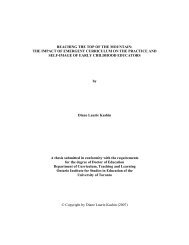Early Childhood Education Program Standard
You also want an ePaper? Increase the reach of your titles
YUMPU automatically turns print PDFs into web optimized ePapers that Google loves.
III. Essential Employability Skills<br />
Context<br />
All graduates of the <strong>Early</strong> <strong>Childhood</strong> <strong>Education</strong> program of instruction have<br />
reliably demonstrated the essential employability skills learning outcomes listed<br />
on the following pages, in addition to achieving the vocational learning outcomes<br />
and meeting the general education requirement.<br />
Essential Employability Skills (EES) are skills that, regardless of a student’s<br />
program or discipline, are critical for success in the workplace, in day-to-day<br />
living, and for lifelong learning.<br />
The teaching and attainment of these EES for students in, and graduates from,<br />
Ontario’s colleges of applied arts and technology are anchored in a set of three<br />
fundamental assumptions:<br />
• these skills are important for every adult to function successfully in society<br />
today;<br />
• our colleges are well equipped and well positioned to prepare graduates<br />
with these skills;<br />
• these skills are equally valuable for all graduates, regardless of the level of<br />
their credential, whether they pursue a career path, or they pursue further<br />
education.<br />
Skill Categories<br />
To capture these skills, the following six categories define the essential areas<br />
where graduates must demonstrate skills and knowledge.<br />
• Communication<br />
• Numeracy<br />
• Critical Thinking & Problem Solving<br />
• Information Management<br />
• Interpersonal<br />
• Personal<br />
Application and Implementation<br />
In each of the six skill categories, there are a number of defining skills, or sub<br />
skills, identified to further articulate the requisite skills identified in the main skill<br />
categories. The following chart illustrates the relationship between the skill<br />
categories, the defining skills within the categories, and learning outcomes to be<br />
achieved by graduates from all postsecondary programs of instruction that lead<br />
<strong>Early</strong> <strong>Childhood</strong> <strong>Education</strong> <strong>Program</strong> <strong>Standard</strong> 22


















